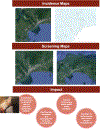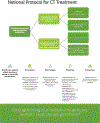Building Programs to Eradicate Toxoplasmosis Part II: Education
- PMID: 36969368
- PMCID: PMC10035399
- DOI: 10.1007/s40124-022-00267-y
Building Programs to Eradicate Toxoplasmosis Part II: Education
Abstract
Purpose of review: Review work to create and evaluate educational materials that could serve as a primary prevention strategy to help both providers and patients in Panama, Colombia, and the USA reduce disease burden of Toxoplasma infections.
Recent findings: Educational programs had not been evaluated for efficacy in Panama, USA, or Colombia.
Summary: Educational programs for high school students, pregnant women, medical students and professionals, scientists, and lay personnel were created. In most settings, short-term effects were evaluated. In Panama, Colombia, and USA, all materials showed short-term utility in transmitting information to learners. These educational materials can serve as a component of larger public health programs to lower disease burden from congenital toxoplasmosis. Future priorities include conducting robust longitudinal studies of whether education correlates with reduced adverse disease outcomes, modifying educational materials as new information regarding region-specific risk factors is discovered, and ensuring materials are widely accessible.
Keywords: Education; Primary prevention; Toxoplasma; Toxoplasmosis.
Conflict of interest statement
Conflict of Interest Denis Limone Pharm D,is Chairman , shareholder and CEO and Raphael Piarroux Pharm D, PhD, is RandD Director and employee at LDBio Diagnostics. A patent application was submitted in the United States for the development of the whole blood point of care test with the scientists at the University of Chicago to insure its continued high quality performance and reproducibility. The authors declare no other competing interests..
Figures







References
-
- Pappas G, Roussos N, Falagas ME. Toxoplasmosis snapshots: global status of Toxoplasma gondii seroprevalence and implications for pregnancy and congenital toxoplasmosis. Int J for Parasitol. 2009;39:1385–94. - PubMed
-
-
McLeod R, Kieffer F, Sautter M, Hosten T, Pelloux H. Why prevent, diagnose and treat congenital toxoplasmosis? Mem Inst Oswaldo Cruz. 2009;104:320–44.
•• Emphasizes the importance of prevention, diagnosis, and treatment initiated promptly to improve outcomes of congenital toxoplasmosis.
-
-
-
Torgerson PR, Mastroiacovo P. The global burden of congenital toxoplasmosis: a systematic review. Bull World Health Organ. 2013;91(7):501–8.
• Provides a comprehensive systematic review of congenital toxoplasmosis incidence and morbidity, as well as effect on quality of life, worldwide.
-
-
-
El Bissati K, Levigne P, Lykins J, Adlaoui EB, Barkat A, Berraho A, Laboudi M, El Mansouri B, Ibrahimi A, Rhajaoui M, Quinn F, Murugesan M, Seghrouchni F, Gomez-Marin JE, Peyron F, McLeod R. Global initiative for congenital toxoplasmosis: an observational and international comparative clinical analysis. Emerg Micr & Inf. 2018;7:165
undefined Summarizes the work done in three countries to address congenital toxoplasmosis and suggests new priorities for research and care. This paper also emphasizes the importance of initiating programs to prevent morbidity and mortality from CT by prenatal screening and treatment
-
Grants and funding
LinkOut - more resources
Full Text Sources
Research Materials
